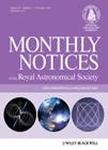版权所有:内蒙古大学图书馆 技术提供:维普资讯• 智图
内蒙古自治区呼和浩特市赛罕区大学西街235号 邮编: 010021

作者机构:Indian Inst Sci Joint Astron Programme Bangalore 560012 Karnataka India Indian Inst Sci Dept Phys Bangalore 560012 Karnataka India Max Planck Inst Radioastron Hugel 69 D-53121 Bonn Germany Boston Univ Inst Astrophys Res Boston MA 02215 USA
出 版 物:《MONTHLY NOTICES OF THE ROYAL ASTRONOMICAL SOCIETY》 (皇家天文学会月报)
年 卷 期:2021年第501卷第4期
页 面:4825-4836页
核心收录:
基 金:DST-INSPIRE [IF160553] MPG through Max-Planck India National Science Foundation [AST-2009842]
主 题:ISM: HII regions ISM: individual objects (DR21) ISM: kinematics and dynamics ISM: Magnetic fields ISM: photodissociation region (PDR) ISM: radio lines
摘 要:Measuring interstellar magnetic fields is extremely important for understanding their role in different evolutionary stages of interstellar clouds and star formation. However, detecting the weak field is observationally challenging. We present measurements of the Zeeman effect in the 1665 and 1667 MHz (18 cm) lines of the hydroxyl radical (OH) lines towards the dense photodissociation region (PDR) associated with the compact Hii region DR 21 (Main). From the OH 18 cm absorption, observed with the Karl G. Jansky Very Large Array, we find that the line-of-sight magnetic field in this region is similar to 0.13 mG. The same transitions in maser emission towards the neighbouring DR 21(OH) and W 75S-FR1 regions also exhibit the Zeeman splitting. Along with the OH data, we use [Cii] 158 mu m line and hydrogen radio recombination line data to constrain the physical conditions and the kinematics of the region. We find the OH column density to be similar to 3.6 x 10(16)(T-ex/25 K) cm(-2), and that the 1665 and 1667 MHz absorption lines are originating from the gas where OH and C+ are co-existing in the PDR. Under reasonable assumptions, we find the measured magnetic field strength for the PDR to be lower than the value expected from the commonly discussed density-magnetic field relation while the field strength values estimated from the maser emission are roughly consistent with the same. Finally, we compare the magnetic field energy density with the overall energetics of DR 21 s PDR and find that, in its current evolutionary stage, the magnetic field is not dynamically important.